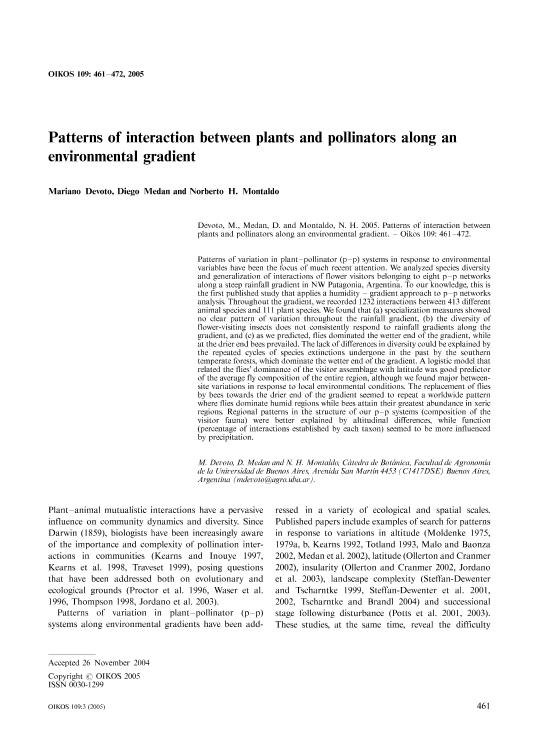Mostrar el registro sencillo del ítem
dc.contributor.author
Devoto, Mariano

dc.contributor.author
Medan, Diego

dc.contributor.author
Montaldo, Norberto Horacio

dc.date.available
2021-05-27T18:43:13Z
dc.date.issued
2005-06
dc.identifier.citation
Devoto, Mariano; Medan, Diego; Montaldo, Norberto Horacio; Patterns of interaction between plants and pollinators along an environmental gradient; Wiley Blackwell Publishing, Inc; Oikos; 109; 3; 6-2005; 461-472
dc.identifier.issn
0030-1299
dc.identifier.uri
http://hdl.handle.net/11336/132683
dc.description.abstract
Patterns of variation in plant-pollinator (p-p) systems in response to environmental variables have been the focus of much recent attention. We analyzed species diversity and generalization of interactions of flower visitors belonging to eight p-p networks along a steep rainfall gradient in NW Patagonia, Argentina. To our knowledge, this is the first published study that applies a humidity - gradient approach to p-p networks analysis. Throughout the gradient, we recorded 1232 interactions between 413 different animal species and 111 plant species. We found that (a) specialization measures showed no clear pattern of variation throughout the rainfall gradient, (b) the diversity of flower-visiting insects does not consistently respond to rainfall gradients along the gradient, and (c) as we predicted, flies dominated the wetter end of the gradient, while at the drier end bees prevailed. The lack of differences in diversity could be explained by the repeated cycles of species extinctions undergone in the past by the southern temperate forests, which dominate the wetter end of the gradient. A logistic model that related the flies' dominance of the visitor assemblage with latitude was good predictor of the average fly composition of the entire region, although we found major between-site variations in response to local environmental conditions. The replacement of flies by bees towards the drier end of the gradient seemed to repeat a worldwide pattern where flies dominate humid regions while bees attain their greatest abundance in xeric regions. Regional patterns in the structure of our p-p systems (composition of the visitor fauna) were better explained by altitudinal differences, while function (percentage of interactions established by each taxon) seemed to be more influenced by precipitation.
dc.format
application/pdf
dc.language.iso
eng
dc.publisher
Wiley Blackwell Publishing, Inc

dc.rights
info:eu-repo/semantics/openAccess
dc.rights.uri
https://creativecommons.org/licenses/by-nc-sa/2.5/ar/
dc.subject.classification
Ciencias de las Plantas, Botánica

dc.subject.classification
Ciencias Biológicas

dc.subject.classification
CIENCIAS NATURALES Y EXACTAS

dc.title
Patterns of interaction between plants and pollinators along an environmental gradient
dc.type
info:eu-repo/semantics/article
dc.type
info:ar-repo/semantics/artículo
dc.type
info:eu-repo/semantics/publishedVersion
dc.date.updated
2021-05-11T18:28:27Z
dc.journal.volume
109
dc.journal.number
3
dc.journal.pagination
461-472
dc.journal.pais
Reino Unido

dc.journal.ciudad
Londres
dc.description.fil
Fil: Devoto, Mariano. Universidad de Buenos Aires. Facultad de Agronomía. Departamento de Recursos Naturales y Ambiente. Cátedra de Botánica Agrícola; Argentina. Consejo Nacional de Investigaciones Científicas y Técnicas. Oficina de Coordinación Administrativa Parque Centenario; Argentina
dc.description.fil
Fil: Medan, Diego. Universidad de Buenos Aires. Facultad de Agronomía. Departamento de Recursos Naturales y Ambiente. Cátedra de Botánica Agrícola; Argentina. Consejo Nacional de Investigaciones Científicas y Técnicas. Oficina de Coordinación Administrativa Parque Centenario; Argentina
dc.description.fil
Fil: Montaldo, Norberto Horacio. Universidad de Buenos Aires. Facultad de Agronomía. Departamento de Recursos Naturales y Ambiente. Cátedra de Botánica Agrícola; Argentina
dc.journal.title
Oikos

dc.relation.alternativeid
info:eu-repo/semantics/altIdentifier/url/https://onlinelibrary.wiley.com/doi/10.1111/j.0030-1299.2005.13712.x
dc.relation.alternativeid
info:eu-repo/semantics/altIdentifier/doi/https://doi.org/10.1111/j.0030-1299.2005.13712.x
Archivos asociados
